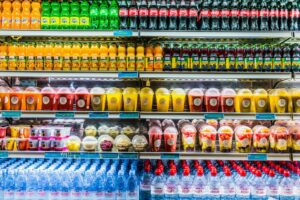Caroline Wood rounds up the debate from the KTN event on Wednesday, 6 November organised in partnership with The UK Circular Plastic Plastics Network and WRAP.
When it comes to reducing plastic waste, recycling is the approach that tends to get all the attention, even though this is itself a resource-intensive process. Furthermore, as our panel speakers from the Ellen MacArthur Foundation and Greenpeace made clear, recycling simply won’t keep pace with our rapidly growing plastic production, set to quadruple by 2050. Replacing plastic with biodegradable or paper alternatives can seem an attractive option, but these also have issues including deforestation; difficulty in recycling paper to food-contact standards and inadequate infrastructure to process biodegradable materials. We need to urgently reduce the volume of plastics in the system, and reuse can play a crucial part in this.
But switching to reusable packaging has impacts, particularly as it has to be durable to withstand multiple uses. As a speaker from WRAP made clear, this decision shouldn’t be emotionally-driven but based on thorough life cycle analysis (LCA) of multiple environmental indicators, besides social impacts and recyclability at end-of-life. Yet such analysis can lead to some uncomfortable truths, as demonstrated by University of Manchester research which showed that circularity does not always equal sustainability. Single-use takeaway containers made from expanded polystyrene (EPS), for instance, are seen as an environmental pollutant as they cannot be recycled and are either landfilled, incinerated or littered. According to LCA however, for many environmental indicators they are far preferable to reusable plastic or aluminium containers. In fact, it would take over 200 uses of a reusable Tupperware box to match a single EPS container in terms of resource depletion. But is this a price worth paying if the volume of waste and pollution is reduced? It’s likely that compromises will always be necessary since no one material will perform best in all respects, making it essential to have a hierarchy of priorities. Different delivery models will also suit different areas, with no ‘one size fits all’ approach. Reuse, for instance, is more effective in densely populated areas where transport distances are minimum.
Even when reuse is clearly the best option, what are the technical, behavioural and economic barriers that hinder uptake? The Plastics: Redefining Single-Use project at the University of Sheffield is investigating these issues, particularly consumer acceptability. In societies conditioned to expect perfect packaging, there is a real concern that consumers will reject packaging that appears too stained or grimy – yet the project’s initial results indicate a surprisingly high level of tolerance. Nevertheless, all speakers agreed that efforts to engage the public should be supported by a strong legislative framework that incentivises reuse models.
The afternoon session presented a rich diversity of case studies which demonstrated that reuse models can have a sound business case and be highly cost-effective, for instance by optimising transport and logistics. Concentrated liquid products designed to be diluted at home (such as waterdrop) are a clear case in point, saving the cost of transporting water unnecessarily. We were also introduced to Loop, a new e-commerce service that delivers products to subscribers in durable containers that are returned, washed and refilled when they become empty. With multiple use, the cost of packaging (besides the environmental footprint) for each good is significantly reduced compared to single-use versions. Investing in packaging also gives the potential for new levels of customer experience and aesthetic design. For instance, the reusable Häagen-Dazs ice cream container in the Loop scheme is said to be perfectly designed for cosy nights in with the television, keeping ice cream frozen for longer and melting top to bottom rather than the other way round. Reusable packaging also offers opportunities for customisation, or smart systems that can gather intelligence and reward loyalty, as the London-based CauliBox scheme shows. This digitally-enabled takeaway box service rewards reuse through points that can be redeemed for goods and experiences.
Yet reuse models bring challenges, from the need to redesign entire supply chains, issues about liability and cross contamination, and the sheer time required to source products or collect returned packaging. It also takes courage to launch an entirely new venture, with no precedents to follow. Another difficulty can be reaching everyone when customer attitudes, awareness and motivation range across a broad continuum. According to the zero-waste consultancy Unpackaged, we can’t assume customers will instinctively know what to do: we need to engage them before they even start the shopping experience. Meanwhile, natural beauty product company Beauty Kitchen admitted that even small increases in inconvenience – such as reusing a ‘pump for life’ on soap bottles- can massively deter the time-poor. But it can be done, as Waitrose’s unpackaged trial store in Oxford showed. We heard how, using strategic communication, customers quickly became accustomed to the different shopping experience and gave overwhelmingly positive feedback. The store also reaped the benefits of global media coverage and attracting a new set of ethical consumers. The younger generation, in particular, show real readiness to engage: for the mobile unpackaged shop Refill and Replenish, much of their custom is driven by the influence of environmentally-conscious children on their parents.
Whilst these ventures give hope, reuse models need to be scaled-up to national levels to have a tangible impact on reducing waste. During the open debate, standardisation of packaging formats was suggested to make this more viable. There also needs to be a fundamental shift in the view of ‘ownership’, so that we can move to models where consumers buy the product but only rent the packaging. With more brands joining ‘the environmental bandwagon’, we also need to be vigilant against greenwash and make the distinction between ‘reusing’ and ‘repurposing’ clear. True reuse should involve the packaging being refilled with exactly the same product, rather than being kept at home as a pencil pot. Ultimately, the best progress may come from approaches that seek completely new ways of delivering products to customers – embracing digital technologies and social media – rather than tweaking the existing system. The event concluded with a presentation from Innovate UK outlining how their Smart Sustainable Plastic Packaging Challenge is the perfect opportunity for visionary thinkers to launch their projects, from large grants for close-to-market propositions, to small-scale feasibility studies.
Ultimately, reducing plastic waste starts with all of us. Since packaging is an intrinsic part of the products we buy, it is up to us to not settle for a ‘single use’, throwaway experience and to discover instead the satisfaction of helping our resources go further.




